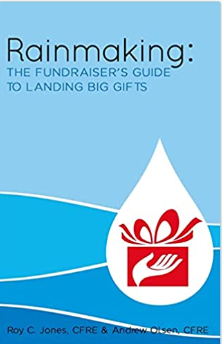
Roy C. Jones
Most organizations use “ask handles” (sometimes called an “ask table”) in order to do upgrade giving through their direct mail fundraising.
When the economy is good most charities will use the donor previous highest gift to calculate the three or four ask amounts in the gift array on the reply device in the letter. In short, the donors previous highest contribution (HPC) is the lowest amount you would ask for… the subsequent amounts might be: HPC; HPCx1.5; HPCx2; and Other.
When the economy is sagging, LIKE NOW, most not-for-profits use the donor’s last gift or average gift as the base to calculate the gift array. This tends not to upgrade too quickly and in most cases upgrades giving more gradually by simply lifting average giving.
Now for the question, “Is a gift array strategy the only tool you should use to upgrade donor participation?”
The obvious answer is “NO”. You must do more in this economy to identify and harvest major gifts from your donor file. I am a big proponent of creating recognition levels to prioritize and benchmark giving. I compare it to having “rungs on a ladder”. Some organizations get frustrated because they only have two rungs on their giving ladder: the low dollar $25 donors and the high dollar bequest or planned givers. With no rungs or levels between entry level giving and estate gifts it is almost impossible to take donors to the top of the giving pyramid.
Creating giving clubs or giving societys based upon the total of annual giving of your donors establishes a benchmark for your donors as well as your organization. It also gives you a process for prioritizing your donor visits and event strategies.
Here are a few tips for improving segmentation and moving donors up the giving ladder:
1. Determine giving levels that challenge your donors to increase their financial support: for example, $1,000, $5,000, $10,000, $50,000, $100,000.
2. Plan to establish at least three giving clubs so donors see the progression in size of gifts – and thus upgrade their contributions: for example, $1000, $5000, and $10,000.
3. Select a name for the giving club(s). Conventional names include Century Club, President’s Society, Founder’s Club, Dean’s Roundtable. Consider, however, names unique to your organization: the name of your founder, a famous member, a historical figure embodying your organization’s mission, or a concept important to your organization.
4. Determine the donor’s benefits at each level: plaques or certificates, parking or library privileges, autographed book, listing of name in program or annual report, access to staff or faculty, invitation to special events.
5. Decide how and where you will recognize and publicize giving club donors: newsletter, plaque, annual report, program, special brochure.
6. Identify board members and key donors who can “seed” each giving club with their contributions. Contact them personally to ask them to serve as charter members.
7. Prepare a brochure for each club or a booklet for all clubs: Describe how the giving club works, stipulating an annual contribution of at least $ _________ for (usually) unrestricted support.
State whether gift can be made in several payments – and whether deferred gifts will be counted (some organizations have a giving club just for those who’ve remembered the organization in their wills).
Identify and illustrate the benefits of membership. List charter members.
8. For higher-level giving clubs, plan an annual special event such as a luncheon, dinner, or seminar. The president or executive director must be on hand. Consider inviting prominent person or special speaker. These events will encourage renewal of contributions.
9. At least once each year, list donors and giving levels for each club in your newsletter, annual report, or (preferably) special publication.

